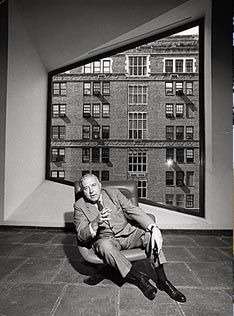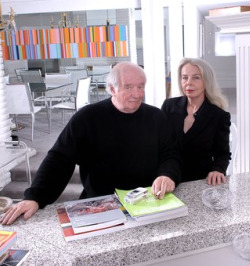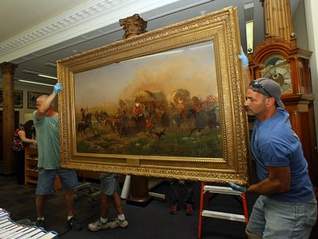Now that all the euphoria has died down about the Whitney Museum’s announcement in May to break ground in downtown Manhattan, it’s time to take a look at a few issues the move raises.
 For a start, in the press coverage, little if any attention was paid to the Whitney’s declining attendance. Yet its drop is far worse than other museums. As I write for the June issue of The Art Newspaper,
For a start, in the press coverage, little if any attention was paid to the Whitney’s declining attendance. Yet its drop is far worse than other museums. As I write for the June issue of The Art Newspaper,
The board’s excitement about the move has as much to do with the building’s location at the south end of the elevated High Line park created on a disused railway line [as it does with the new space]. The site is seen as the answer to the Whitney’s attendance problem. Last year the museum drew a meagre 322,000 visitors–a sharp decline from past years. In the late 1990s the museum regularly attracted 650,000 to 670,000 visitors.
[But] New York’s meatpacking district hums with activity morning, day and night, and the High Line, which opened in June 2009, attracted more than two million visitors in its first year. “Many of these people will wander into the Whitney, and be smitten with art,” hopes a board member.”The core of people that go to the Whitney will grow exponentially.”
UPDATED: I should have added here that neither the Metropolitan Museum, nor the Museum of Modern Art, have trouble attracting audiences uptown. MoMA’s in particular is the younger audience the Whitney seems to crave.
So why should the Whitney have problems? Something has obviously gone wrong with its programming. Museums like the Whitney should, if they’re programming well, offer a mix of programming. I suspect that’s part of the Whitney’s problem. It may also be marketing, or lack thereof.
But a move downtown may not solve this problem. The Guggenheim’s Soho outpost, after all, failed.
NOW BACK TO THE ORIGINAL POST:
Whitney staff is also working now with architect Renzo Piano, brainstorming how all the new space, including outdoor terraces, might go beyond the “white box” look.
And the Whitney board is considering nighttime hours, according to Joanne Leonhardt Cassullo, a longtime trustee. That’s something I’ve argued for here. The Whitney currently closes at 6pm, and 9pm on Fridays, and I hope the trustees will blaze a trail here for other museums — staying open until 8 or 9 most nights, even if it means opening at noon.
The Whitney is mum on what it will do — long-term — with the uptown Breuer building (it can’t afford two buildings, most outsiders say), probably because it doesn’t know. The posssible leasing deal with the Metropolitan Museum is short-term.
At my suggestion, The Art Newspaper asked a couple of people for their thoughts on the long-term. My own feelings align most closely with those of David Ross, a former director, who said, in part:
…an idea that has for quite some time has intrigued me, would be that the Whitney and the Metropolitan Museum (and possibly even MoMA and the Studio Museum in Harlem) would collaborate on a space devoted to an expansive presentation of early though mid-century 20th-century American Art. The building is perfectly suited to the exhibition of American Modernism, and frankly, neither the Met nor MoMA devote enough major space or sufficient resources to this period, and the Studio Museum is years away from being able to provide space appropriate to its important mission.
I hadn’t thought about the need for collaboration, but I love the idea of a museum of American Modernism.
(That’s Breuer in his Whitney in the photo, btw.)
Photo Credit: Courtesy of The Art Newspaper


 Today’s Wall Street Journal recaps more gory details: plans for a contemporary art museum were scrapped, a sculpture park on which the city spent $700,000 “sits empty,” awaiting private funds, and now two arts partrons — Dave Hickey and Libby Lumpkin, who “propelled the city’s artistic ambitions” — are moving out. Both academics, they’re joining the faculty of the University of New Mexico, because they could not find work in Las Vegas (particularly, a full-time post for Lumpkin at UNLV,
Today’s Wall Street Journal recaps more gory details: plans for a contemporary art museum were scrapped, a sculpture park on which the city spent $700,000 “sits empty,” awaiting private funds, and now two arts partrons — Dave Hickey and Libby Lumpkin, who “propelled the city’s artistic ambitions” — are moving out. Both academics, they’re joining the faculty of the University of New Mexico, because they could not find work in Las Vegas (particularly, a full-time post for Lumpkin at UNLV,  This spring, the
This spring, the  A few days ago, the
A few days ago, the  The Dover Library owns about 55,000 books, plus other reading/listening/viewing materials. Dover’s population is less than 18,000.
The Dover Library owns about 55,000 books, plus other reading/listening/viewing materials. Dover’s population is less than 18,000.